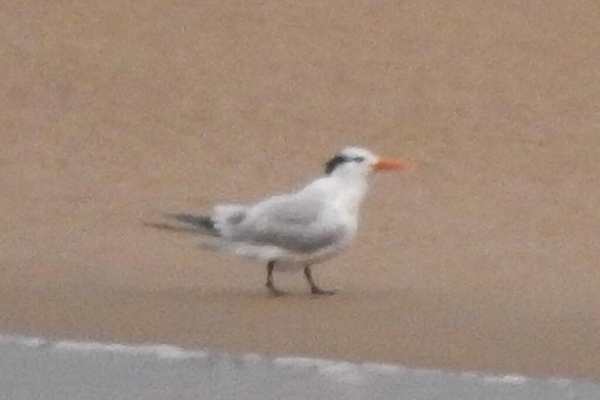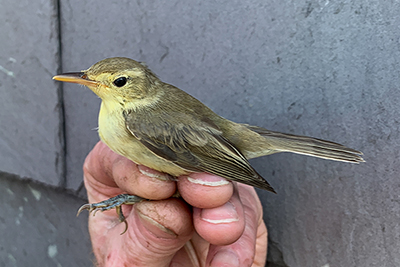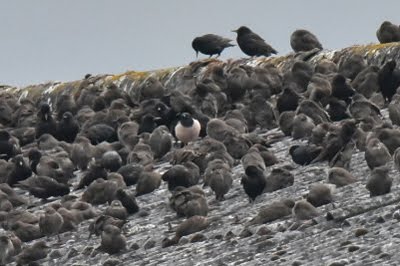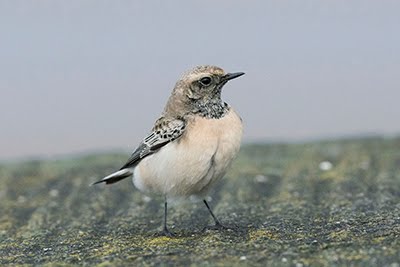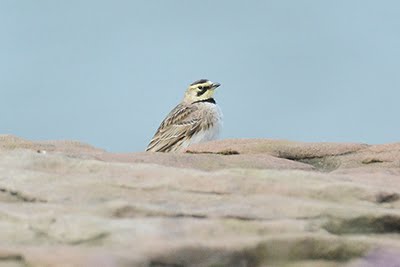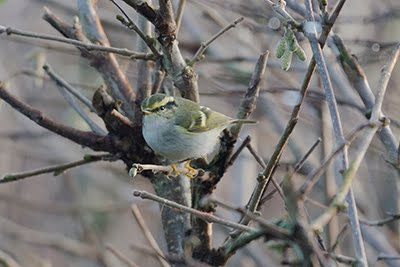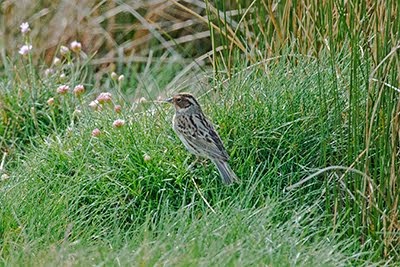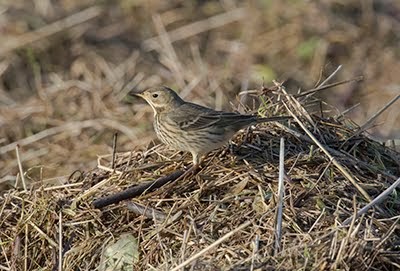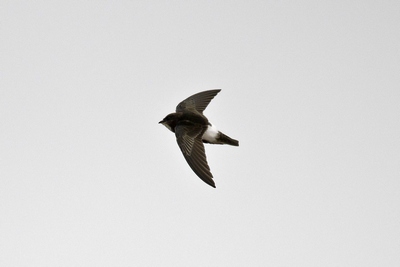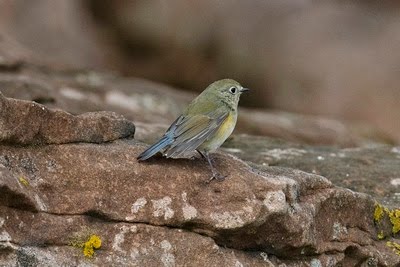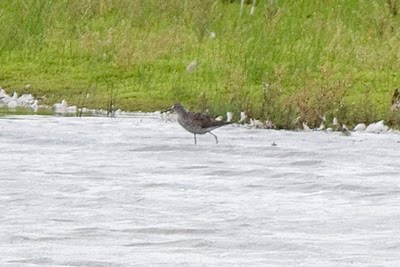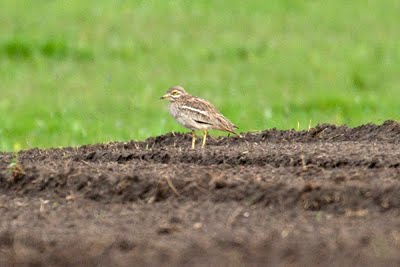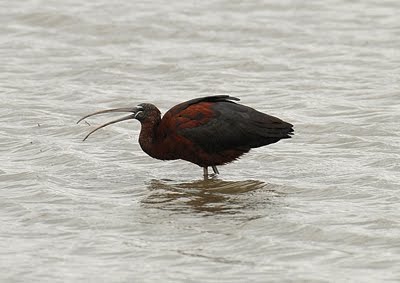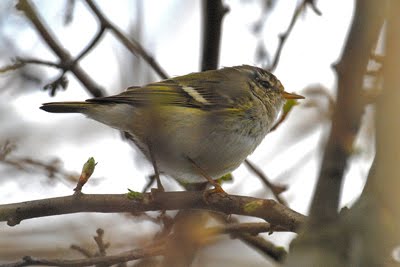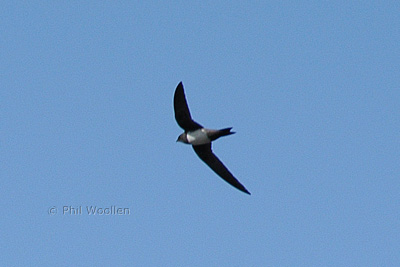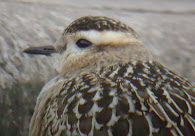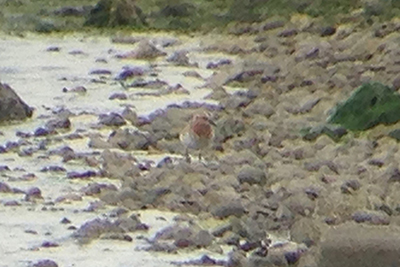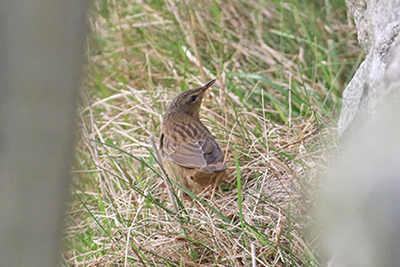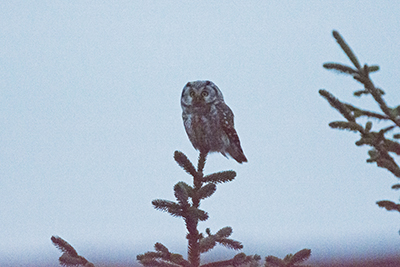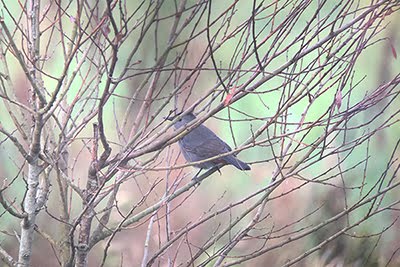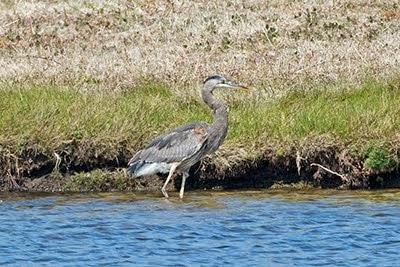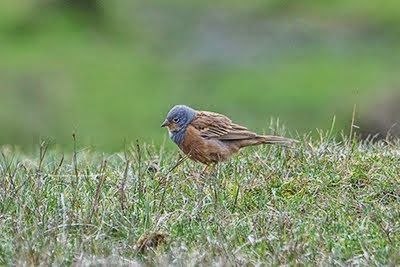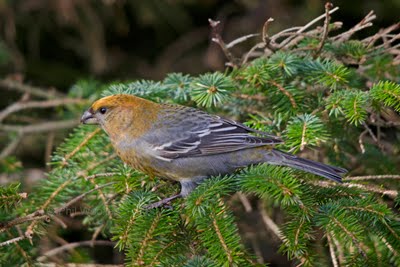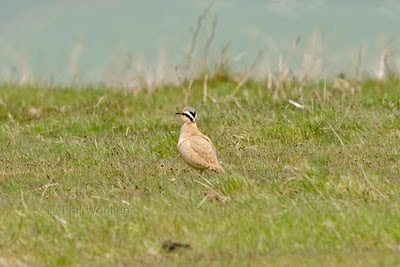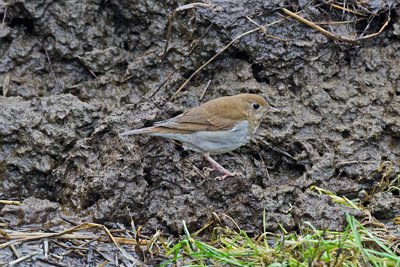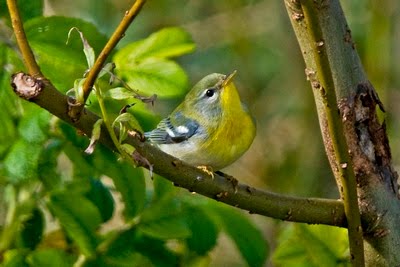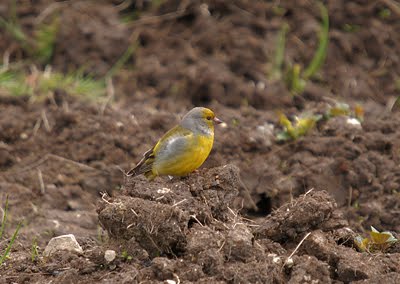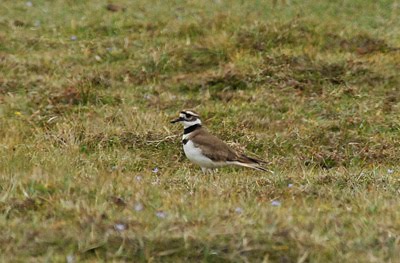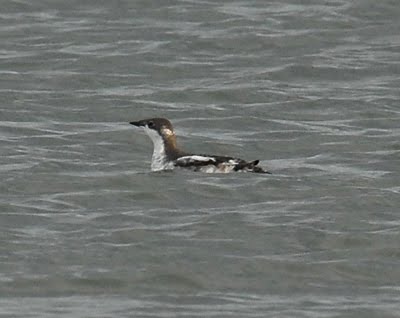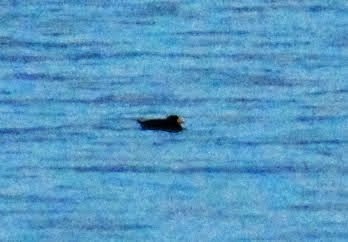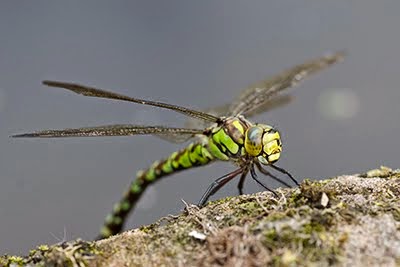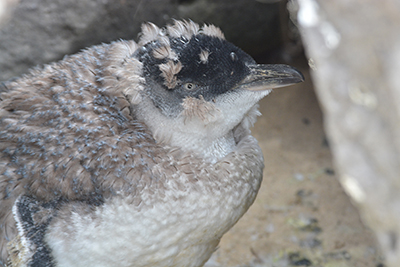2018 was a year of many changes for me personally. Jan & I were blessed with two healthy and beautiful new grandchildren, Penny & Oliver to join Lizzie but at the other end of the spectrum of life we lost my dad who finally succumbed to his vascular dementia. He was a major inspiration to me in both my professional life and and in his love of nature and the outdoor world.
There have been major changes in my professional life as well as I made the momentous decision to hand my notice in back in March and take early retirement at the end of this year.
Birding wise it was pretty quiet. The only 'lifer' for me involving a long distance twitch was Cornwalls famous Gray Catbird (note the deliberate American spelling! A great day out and a lot of people were very happy after missing the Anglesey bird and the controversy surrounding that bird and a Saturday..................See here for details of an epic day out.
The Royal Tern on Anglesey in December may eventually get split so potentially there will be two species of Royal Tern on the UK list (assuming the bird at Porthmadog in 2009 gets submitted and accepted as African Royal Tern). See here for details of the Royal Tern twitch.
Royal Tern photo's @ Malc Curtin
Apart from that my only other two new British birds were both 'armchair' ticks with the Cornish Dalmation Pelican and N Wales Elegant Tern being accepted onto the British list.
My Cheshire list increased by three this year with the addition of the superb Pied Wheatear at Meols (which was discovered a few days previously but not identified until two days later from photos) a Chough at Caldy and A Snow Goose at Neston with Pinkfooted Geese.
Another good Cheshire bird was the Bonepartes Gull found by Tim Kinch at Meols and then re-found on Hilbre by Chris Williams. Not a Cheshire tick for me but certainly the first for Hilbre! My first Cheshire Bonepartes gull was seen at Inner Marsh Farm RSPBin the evening of 20th May 2004 and didn't hang around. Luckily the more recent bird stuck around for the majority of people who wanted to see it.
Sadly our annual trip to Shetland / Fair Isle had to be cancelled due to bad weather and Dads funeral but I've already booked for 2019. However, I had my annual fix of small islands when I was invited to join the regular trip to Nan Ron to catch and ring Storm Petrels. See here for details of that superb trip.
Once I'd handed my notice in the company really went for their pound of flesh and work commitments meant I couldn't get to Hilbre as much as I'd liked to. Hopefully I'll be able to spend more time on the island in the next few years.
2019 will bring many changes for a lot of people We can only hope that there will be positive changes for our native wildlife. Heres wishing everyone a happy bird-filled 2019!
31 Dec 2018
29 Dec 2018
Post Christmas trip to Hilbre
A beautifully mild Christmas Day & Boxing Day merged into one large family get together to celebrate the festive season. Following the noise and bustle associated with such gathering a bit of peace and solitude, if not goodwill, was called for so when Al invited me to join him on a trip to Hilbre to stay over the tide I jumped at the chance. Especially as there was the promise of home made hot pot!
Arriving at the Obs the wood stove was lit to dry the place and get rid of the moisture in the air. With the gas turned on and the kettle boiling it wasn't long before we were enjoying the first of many brews before turning our attention to the birds.
Once again we were struck as to how mild the weather was and with a flat calm sea and good visibility we spent a lot of time scanning the sea. A small number of Red-throated Divers were picked up with slightly more Great-crested grebes and several hundred Common Scoter.
Two Purple Sandpipers at the north end were joined by three more and eventually roosted as they were forced off the rocks by the rising tide. I never get tired of seeing these little birds and its worrying that their numbers on Hilbre are declining so rapidly. Even I, a relative newcomer on the scene, can remember flocks of 20+ Purple Sandpipers wintering around Hilbre's rocky shores but now we are down to single figures.
As the tide rose the resident female Eider vacated her position on the Whale-back and was later seen roosting up on Middle Eye over the high tide along with several thousand Oystercatchers and good numbers of Curlew that had also been feeding along the seaweed covered rocks.
As the tide rose higher a flock of Ringed Plover flew around looking for a roosting site before eventually settling on the rock ledges to the west of the access ramp onto the island.
By now the short winter day was drawing to a close and the light was beginning to fade. Bellies full of Hotpot we scanned the shoreline and sea as the tide began to drop and eventually left the island in the dark to return to the mainland.
Another great day out and just the antidote to a manic couple of days over Christmas.
Arriving at the Obs the wood stove was lit to dry the place and get rid of the moisture in the air. With the gas turned on and the kettle boiling it wasn't long before we were enjoying the first of many brews before turning our attention to the birds.
Once again we were struck as to how mild the weather was and with a flat calm sea and good visibility we spent a lot of time scanning the sea. A small number of Red-throated Divers were picked up with slightly more Great-crested grebes and several hundred Common Scoter.
Two Purple Sandpipers at the north end were joined by three more and eventually roosted as they were forced off the rocks by the rising tide. I never get tired of seeing these little birds and its worrying that their numbers on Hilbre are declining so rapidly. Even I, a relative newcomer on the scene, can remember flocks of 20+ Purple Sandpipers wintering around Hilbre's rocky shores but now we are down to single figures.
As the tide rose the resident female Eider vacated her position on the Whale-back and was later seen roosting up on Middle Eye over the high tide along with several thousand Oystercatchers and good numbers of Curlew that had also been feeding along the seaweed covered rocks.
As the tide rose higher a flock of Ringed Plover flew around looking for a roosting site before eventually settling on the rock ledges to the west of the access ramp onto the island.
By now the short winter day was drawing to a close and the light was beginning to fade. Bellies full of Hotpot we scanned the shoreline and sea as the tide began to drop and eventually left the island in the dark to return to the mainland.
Another great day out and just the antidote to a manic couple of days over Christmas.
17 Dec 2018
Rigning Martin Mere WWT
I was lucky enough to be part of a SCAN team invited to help the regular Martin Mere ringing team catch and ring Whooper Swans and a few duck species at the weekend. Initially we were going Saturday but the weather deteriorated so a decision was made to go Sunday - only for the decision to be reversed again when a weather window opened itself up to an opportunity to revert back to Saturday!
Leaving the house at 5.30 Saturday morning, after a restless night ( I never sleep well when I know the alarms going off early), it soon became apparent that the weather was bitterly cold! I had ice on the inside of the Landrover windscreen. I soon warmed up though and and 90 minutes later had to brave the freezing cold again when I arrived at Martin Mere.
With the team assembled a briefing was given by the ringer in charge and with everyone knowing their roles we started our catch.
We ended up with 73 Whooper Swans of which 38 were new birds and 35 re-traps from previous years. All birds were ringed and a 'darvic' colour ring added, aged, sexed, weighed and a wing length taken before releasing. They were wrapped in 'swan blankets' to keep them calm and the process was carried out with the minimum amount of noise and fuss by an experienced team. Sadly even several of these beautiful birds showed some evidence of past gunshot wounds.
As well as the Whoopers we caught 54 Shelduck - exactly half were re-traps with the oldest being from 2002. Another had been ringed in 2007 and not encountered since whilst yet another ringed in 2005 has had its ring read 20 times since then in the field.
I'd ringed Whoopers and Shelducks before but never Pintail or Coot so was really happy to get the opportunity to do so. Pintail are simply stunning!
As with other male ducks ageing depends on a combination of features - the presence or absence of juvenile tail feathers or median and lesser coverts and the demarkation between the colours on the outermost tertial.
From the photo below you can see the tertial has a distinct demarkation between the black and the 'pearl' and also has a very narrow fringe. This ages this bird as an adult male, Euring 4.
We caught one re-trap male Teal and the same ageing criteria can be used - again the border between the black and 'pearl' on the inner tertial is very clean and distinct making this an adult.
Leaving the house at 5.30 Saturday morning, after a restless night ( I never sleep well when I know the alarms going off early), it soon became apparent that the weather was bitterly cold! I had ice on the inside of the Landrover windscreen. I soon warmed up though and and 90 minutes later had to brave the freezing cold again when I arrived at Martin Mere.
With the team assembled a briefing was given by the ringer in charge and with everyone knowing their roles we started our catch.
We ended up with 73 Whooper Swans of which 38 were new birds and 35 re-traps from previous years. All birds were ringed and a 'darvic' colour ring added, aged, sexed, weighed and a wing length taken before releasing. They were wrapped in 'swan blankets' to keep them calm and the process was carried out with the minimum amount of noise and fuss by an experienced team. Sadly even several of these beautiful birds showed some evidence of past gunshot wounds.
As well as the Whoopers we caught 54 Shelduck - exactly half were re-traps with the oldest being from 2002. Another had been ringed in 2007 and not encountered since whilst yet another ringed in 2005 has had its ring read 20 times since then in the field.
I'd ringed Whoopers and Shelducks before but never Pintail or Coot so was really happy to get the opportunity to do so. Pintail are simply stunning!
As with other male ducks ageing depends on a combination of features - the presence or absence of juvenile tail feathers or median and lesser coverts and the demarkation between the colours on the outermost tertial.
From the photo below you can see the tertial has a distinct demarkation between the black and the 'pearl' and also has a very narrow fringe. This ages this bird as an adult male, Euring 4.
We caught one re-trap male Teal and the same ageing criteria can be used - again the border between the black and 'pearl' on the inner tertial is very clean and distinct making this an adult.
Coot are know to be wriggly, belligerent and scratchy and willing to fight each other and anything else that happens to upset them. I'd never ringed one before but go the opportunity Saturday and was surprised at how small they were in the hand. Small they may be but just look at those feet!
Like the swans each Coot was fitted with a darvic ring to enable it to be identified in the field and released back on to the main mere.
With the catch processed by 11.00 there was time for a quick hot drink and a chocolate biscuit before the predicted weather window closed and the heavens opened! A great experience and one I hope to take part in again.
12 Dec 2018
Royalty visits the island of the druids.
Earlier this year a long staying American Royal Tern that had been on the Channel Islands shifted temporarily to the south coast. Royal tern is currently split into two subspecies - African and American. The Channel island bird had an American banding association ring on its right leg as did the Pagham bird so the assumption is they're the same bird. I wasn't to bothered as I'd seen) the N Wales bird in 2009 that I refound at Black Rock Sands, Porthmadog.
See crap photo below:
Many of the local N Wales and Cheshire / Wirral birders got to see this bird before it got dark but unfortunately it had gone the next morning only to reappear a few weeks later at Llandudno for a few short hours.
The feeling was at the time that this may have been of the African subspecies as there are subtle differences in structure and also the bill size / colouration.
However, the IOC, whose taxonomy the BBRC have adopted, have recommended Royal Tern be split into two species.
Cue wild-spread interest when twitter lit up to say a Royal Tern ringed on the right leg had turned up on Anglesey. Less than an hour from the office! With no time to get there on the day it was found (Monday) a Hilbre team made a tentative plan to travel on the Tuesday picking me up via Mold where my car was going in for a service.
News duly broke early that the bird was still there and the twitch was on. We made the journey in good time to find the bird had temporarily disappeared round a headland. After waiting for awhile I decided to walk round the headland only to get a phone call about 30 minutes later to say it was back in the bay!
For the next few hours it foraged from bay to bay occasionally settling briefly and providing great views to the assembled throng of appreciative birders.
Photos courtesy of Malc Curtin.
The assumption is of course that this is probably the same bird that was in the Channel Islands as its ringed on the right leg. Apparently there is a paper in the offing that will give pointers to the separation of the two sub species in the field so it could be the previous N Wales bird could eventually be identified as African!
An excellent short twitch and many thanks to the Stig who drove and Mr Stato who's lovely wife provided the nourishment in the for mof home baked muffins and cookies!
See crap photo below:
Many of the local N Wales and Cheshire / Wirral birders got to see this bird before it got dark but unfortunately it had gone the next morning only to reappear a few weeks later at Llandudno for a few short hours.
The feeling was at the time that this may have been of the African subspecies as there are subtle differences in structure and also the bill size / colouration.
However, the IOC, whose taxonomy the BBRC have adopted, have recommended Royal Tern be split into two species.
Cue wild-spread interest when twitter lit up to say a Royal Tern ringed on the right leg had turned up on Anglesey. Less than an hour from the office! With no time to get there on the day it was found (Monday) a Hilbre team made a tentative plan to travel on the Tuesday picking me up via Mold where my car was going in for a service.
News duly broke early that the bird was still there and the twitch was on. We made the journey in good time to find the bird had temporarily disappeared round a headland. After waiting for awhile I decided to walk round the headland only to get a phone call about 30 minutes later to say it was back in the bay!
For the next few hours it foraged from bay to bay occasionally settling briefly and providing great views to the assembled throng of appreciative birders.
Photos courtesy of Malc Curtin.
The assumption is of course that this is probably the same bird that was in the Channel Islands as its ringed on the right leg. Apparently there is a paper in the offing that will give pointers to the separation of the two sub species in the field so it could be the previous N Wales bird could eventually be identified as African!
An excellent short twitch and many thanks to the Stig who drove and Mr Stato who's lovely wife provided the nourishment in the for mof home baked muffins and cookies!
10 Dec 2018
Unexpected item in the feeding area!
Not much happening recently bird wise due to work commitments. I managed to catch a couple of Redwing and Blackbirds in the garden before they demolished all the holly berries and moved on to the next food source.
A real garden 'mega' though this weekend when I looked out to se a juvenile Moorhen beneath the feeders. The nearest pond is several hundred metres away!
A real garden 'mega' though this weekend when I looked out to se a juvenile Moorhen beneath the feeders. The nearest pond is several hundred metres away!
17 Nov 2018
Eider, Hilbre
I forgot about these photo's of Eider on Hilbre! One of the features this year on Hilbre has been the number of Eider loafing around the island. On quiet days sitting in the Obs we specualte as to whether these birds are from the population at Walney in Cumbria or Puffin Island, Anglesey. Puffin Island is probably closer and the population there is increasing.
These photos were taken back in September and show a sub adult male and a juvenile - probably a male from the whit beginning to show through on the breast although that may just be misplaced feathers.
Wherever they come from they're always a nice addition to the Hilbre day list!
These photos were taken back in September and show a sub adult male and a juvenile - probably a male from the whit beginning to show through on the breast although that may just be misplaced feathers.
Wherever they come from they're always a nice addition to the Hilbre day list!
9 Nov 2018
Pied Wheatear - a potential first for Cheshire & Wirral
When Richard Ashford took some photos of a late Wheatear at on the sea defences at Meols on Monday and Tuesday this week and forwarded them to Richard Smith little did he know what he'd found. Richard circulated them and Steve's immediate reaction was 'shit, thats no Northern'
Other photos showing the tail pattern confirmed it as potentially Cheshire and Wirrals first Pied Wheatear. Potentially as one of the Hilbre Bird Observatory founder members recalls finding one with the late John Gittins but it was never submitted.
Steve put the news out on the local WhatsApps group Tuesday night and cue much angst amongst the Wirral and Cheshire birding fraternity. A major rarity on our doorstep for two days and nobody had realised. Would it be there the next day? With a trip to Somerset later on the Wednesday I set the alarm for 6 am and aimed to get to site just after 1st light.
Tuesday night was wet and miserable so it was hoped the bird would have roosted and still be there in the morning. Luckily it was and Al C, who lives within a mealworms throw of the site, put the news out the bird was still there as I was driving up the Wirral peninsula.
Expecting the bird to have moved further along the coast, perhaps into the dunes or pony paddocks, I put my wellies on only to pull up behind a line of other cars and have the Pied Wheatear land on the seawall next to me. That was the pattern for the next hour or so. The bird was completely unconcerned by its growing crowd of admirers, dog walkers, cyclists or parents walking their children to school. It would flit over the sea defences to reappear a few metres away. As the light improved slightly so my photos got slightly better.
It was feeding well on small black flies that were probably hatching from the rottens seaweed on the beach just below the sea defences. It was also seen catching wasps.
My only concern when I viewed the photos was that the tail pattern (see out of focus shot below) was closer to the illustration of Eastern Black-eared Wheatear in Collins but I think everyone is happy that it is a Pied Wheatear and looking closely you can see the scaly mantle feathers.
Amazingly the Wirral hasn't had a Desert Wheatear! Now we've had something even rarer. Over the years I've seen Desert Wheatear on the beach at Crosby, on the beach at Rhyl and an adult spring male at Irlam, Greater Manchester. All around us but not yet here. Surely that must be a good bet soon.
Other photos showing the tail pattern confirmed it as potentially Cheshire and Wirrals first Pied Wheatear. Potentially as one of the Hilbre Bird Observatory founder members recalls finding one with the late John Gittins but it was never submitted.
Steve put the news out on the local WhatsApps group Tuesday night and cue much angst amongst the Wirral and Cheshire birding fraternity. A major rarity on our doorstep for two days and nobody had realised. Would it be there the next day? With a trip to Somerset later on the Wednesday I set the alarm for 6 am and aimed to get to site just after 1st light.
Tuesday night was wet and miserable so it was hoped the bird would have roosted and still be there in the morning. Luckily it was and Al C, who lives within a mealworms throw of the site, put the news out the bird was still there as I was driving up the Wirral peninsula.
Expecting the bird to have moved further along the coast, perhaps into the dunes or pony paddocks, I put my wellies on only to pull up behind a line of other cars and have the Pied Wheatear land on the seawall next to me. That was the pattern for the next hour or so. The bird was completely unconcerned by its growing crowd of admirers, dog walkers, cyclists or parents walking their children to school. It would flit over the sea defences to reappear a few metres away. As the light improved slightly so my photos got slightly better.
It was feeding well on small black flies that were probably hatching from the rottens seaweed on the beach just below the sea defences. It was also seen catching wasps.
My only concern when I viewed the photos was that the tail pattern (see out of focus shot below) was closer to the illustration of Eastern Black-eared Wheatear in Collins but I think everyone is happy that it is a Pied Wheatear and looking closely you can see the scaly mantle feathers.
Amazingly the Wirral hasn't had a Desert Wheatear! Now we've had something even rarer. Over the years I've seen Desert Wheatear on the beach at Crosby, on the beach at Rhyl and an adult spring male at Irlam, Greater Manchester. All around us but not yet here. Surely that must be a good bet soon.
23 Oct 2018
Catbird video
I've just editied a short video I took of the Lands End Gray Catbird taken last Wednesday. Brilliant as the bird was in cover when I took it but I'm pleased to have got anything at all seeing as I'm pretty crap at hand holding the phone to the scope.
As of today (Tuesday 23rd October) the bird is still present and has probably been the bird of the year so far.
A garden regular
This male pheasant has been a regular garden visitor for the last two autumns we've been in the house. It obviously knows when the pheasant shooting season starts (1st October) and 'retires' to our garden to avoid getting shot. Pheasants aren't released on the farmland near us but the farmer does allow rough shooting on his land so this bird knows where it'll be safe.
Although introduced and not truly wild its still a stunning bird to see regularly in the garden.
Although introduced and not truly wild its still a stunning bird to see regularly in the garden.
17 Oct 2018
Not a Saturday Catbird.
When a Gray Catbird turned up on Anglesey on Thursday4th October 2001 I was the other side of the World trying to cope with the searing humidity of wearing a suit to meetings in Malaysia. The bird was mired in a certain amount of controversy as it was typically elusive and there were allegations and counter allegations as some people claimed to have seen it on the Saturday when the majority didn't. A good friend, now sadly deceased and greatly missed, saw the bird on the Saturday and had to put up with years of malcontent form the disgruntled majority who didn't see it on that day claiming the lucky few had seen a Blackcap.
Roll forward 2018 and with an abortive attempt for a first for Britain on the Monday news broke late of a 2nd Gray Catbird near Lands End in Cornwall. Family comes first and a recent bereavement meant I couldn't make the journey down at first light on Tuesday. Luckily I had the offer of a lift to get there and back on Wednesday (today) so I quickly decided it was worth a punt.
Meeting up at 00.45 with my elective chauffeur we made good progress and arrived on site in darkness around 06.45. One of the prospects I relish about these twitches is meeting up with old friends I hadn't seen for years but the talking had to come later. More importantly was the Catbird still here?
A tense 45 minutes ensued as it got lighter before Mark Sutton shouted he'd got it perched up in blackthorn around 60 m away. Everyone got on it before the bird flew towards us and landed in scrub willows around 15 m in front of us. From then onwards it showed exceptionally well on occasions before diving into thick cover and reappearing further down the line of assembled birders.
Great. This skulker was showing really well and I hadn't bothered bringing my camera as I was expecting brief views only and the weather forecast said it was going to rain whereas the bird performed in sunshine! Arse, as our good friend would have said.
I'd even left the digi-scoping adaptor in the boot of the chauffeur driven limousine and had to rely on hand holding my phone to the 'scope to get any record shots.
A great day out and for once the motorways were relatively painless. Many thanks to my anonymous chauffeur for doing all the driving.
Now maybe those sourpusses who've been chunnering on about the Saturday Catbird since 2001 can finally lay their demons to rest.
Roll forward 2018 and with an abortive attempt for a first for Britain on the Monday news broke late of a 2nd Gray Catbird near Lands End in Cornwall. Family comes first and a recent bereavement meant I couldn't make the journey down at first light on Tuesday. Luckily I had the offer of a lift to get there and back on Wednesday (today) so I quickly decided it was worth a punt.
Meeting up at 00.45 with my elective chauffeur we made good progress and arrived on site in darkness around 06.45. One of the prospects I relish about these twitches is meeting up with old friends I hadn't seen for years but the talking had to come later. More importantly was the Catbird still here?
A tense 45 minutes ensued as it got lighter before Mark Sutton shouted he'd got it perched up in blackthorn around 60 m away. Everyone got on it before the bird flew towards us and landed in scrub willows around 15 m in front of us. From then onwards it showed exceptionally well on occasions before diving into thick cover and reappearing further down the line of assembled birders.
Great. This skulker was showing really well and I hadn't bothered bringing my camera as I was expecting brief views only and the weather forecast said it was going to rain whereas the bird performed in sunshine! Arse, as our good friend would have said.
I'd even left the digi-scoping adaptor in the boot of the chauffeur driven limousine and had to rely on hand holding my phone to the 'scope to get any record shots.
A great day out and for once the motorways were relatively painless. Many thanks to my anonymous chauffeur for doing all the driving.
Now maybe those sourpusses who've been chunnering on about the Saturday Catbird since 2001 can finally lay their demons to rest.
16 Oct 2018
Choughing Nora
A great couple of hours local birding after the disappointment of not being able to get to Fair Isle and dipping the White-rumped Swift in Yorkshire. There've been a few Choughs seen in Cheshire and Wirral over the years but most have been flyovers or very brief stayers. Thank you to whoever reported this bird near Caldy today and thanks for Steve for putting the news out! A Cheshire and Wirral first for many people including me.
A bird was seen and photographed recently on Hilbre but that one had a green colour ring on one leg. This bird is a different individual as its un-ringed.
When the news came out I was at home but 30 minutes later I was yomping the short distance along the beach to where Al & Steve were watching the bird on rocks below just north of the Dee Estuary Sailing Club.
I don't think there'll be any issues getting this through the Cheshire rarities committee.
A bird was seen and photographed recently on Hilbre but that one had a green colour ring on one leg. This bird is a different individual as its un-ringed.
When the news came out I was at home but 30 minutes later I was yomping the short distance along the beach to where Al & Steve were watching the bird on rocks below just north of the Dee Estuary Sailing Club.
Subscribe to:
Posts
(
Atom
)
























